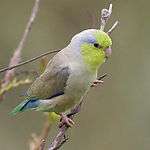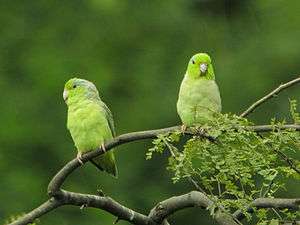Pacific parrotlet

Blue male Pacific Parrotlet
The Pacific parrotlet (Forpus coelestis), also known as Lesson's parrotlet or the celestial parrotlet, is a species of small parrot in the family Psittacidae, native to Ecuador and Peru. Its natural habitats are subtropical or tropical dry forests, subtropical or tropical moist lowland forests, subtropical or tropical dry shrubland, and heavily degraded former forest.
Parrotlets are the second smallest group of all parrots. Pacific parrotlets are between 4½ to 5½ inches long. The average weight is 34-44 grams in the wild. They come from the South American countries of Peru and Ecuador. There are seven species of parrotlets in the genus Forpus. Only three of these species are kept as pets. Of these, the Pacific parrotlet is the most common.
Description

Male in Peru
The Pacific parrotlets have olive green and grey bodies and lighter blue streaking back from their eyes. It is a dimorphic species. The males have a striking cobalt rump with blue patches on their wings and lighter yellowish green faces. Females are mostly green with much less brightly colored blue patches behind the eyes and no cobalt rump or blue in their wings. These dimorphic color variations are true of most of the color mutations as well. They are from 10 cm - 14 cm long.
Aviculture
This species is not very common in pet stores in the USA and is valued by breeders. Its normal price range is 150-200 USD. This price is much lower than other species because since 1930 the US has had an established breeding population in captivity, before the CITES laws preventing importing wildlife from foreign countries. Some of the color mutations in aviculture include blue, American yellow, American White, European yellow and white, fallow, dark factor green and lutino. Captive bred Pacific parrotlets can be expected to live between 10 and 15 years with good care and regular veterinary examinations, although individuals may have shorter or longer life spans.
| Blue color mutants and a normal green wild-type |
| Blue female using a foot to scratch her head |
| Female blue and male green Pacific parrotlets |
| Male green Pacific parrotlet, named Jackson |
|
References







.jpg)

